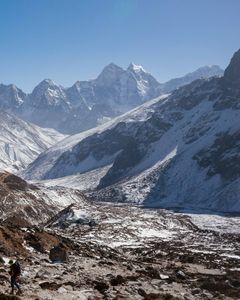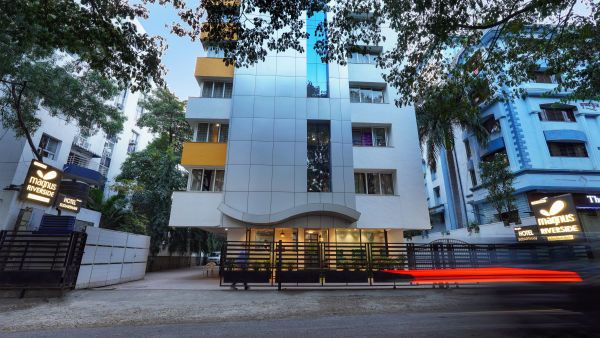Everest Base Camp Trek Distance: Conquer 130 km of Himalayan Adventure
 Deepanshu Negi
28 Aug, 2025
8 mins read
38
Deepanshu Negi
28 Aug, 2025
8 mins read
38

For many trekkers, reaching Everest Base Camp (EBC) is not just a trek, but a lifelong dream. Standing at the foot of the world’s highest mountain, Mount Everest (8,848 m), is an achievement that combines adventure, endurance, and the sheer beauty of the Himalayas.
But before setting off, one of the most common questions trekkers ask is: “How far is the Everest Base Camp trek?â€
The answer is simple yet challenging: the Everest Base Camp trek distance is around 130 kilometers (round trip). While 130 km may not sound like much compared to long-distance hikes or marathons, the Himalayan terrain makes this journey a true test of determination.
Understanding the Distance
The trek covers approximately 65 kilometers from Lukla to Everest Base Camp and the same distance back, making it a 130 km round trip. Unlike flat trails or city walks, every kilometer in the Himalayas comes with steep ascents, rocky paths, hanging bridges, and thin mountain air.
This distance usually takes about 12–14 days to complete, with most trekkers walking 10–15 kilometers per day. While this might sound modest, the altitude, terrain, and weather make every step a meaningful effort.
Why the Distance Feels Tougher Than It Sounds
Many trekkers underestimate the 130 km because it doesn’t sound very long. After all, on a smooth road, you could cover that distance in a few days of cycling or even running. But on the Everest Base Camp trek, distance takes on a whole new meaning.
Here’s why:
- High Altitude: Beyond 3,000 meters, the air becomes thinner. By the time you reach 5,000 meters near EBC, your body gets only about 50% of the oxygen available at sea level. Even short walks can feel exhausting.
- Steep Climbs & Descents: Unlike flat routes, the trail continuously goes uphill and downhill, challenging your stamina and knees.
- Changing Weather: Bright mornings may turn into snowy afternoons, making the same distance much harder.
- Terrain Variety: From forests and suspension bridges to rocky moraines and glacial paths, the terrain changes constantly, testing balance and endurance.
How Trekkers Experience the 130 km
On average, trekkers walk for 5–7 hours a day, covering 10–15 km. The pace is deliberately slow because rushing at altitude increases the risk of Acute Mountain Sickness (AMS). The trek also includes acclimatization days, where trekkers stay at the same altitude but go on short hikes to prepare their bodies.
The distance is not just about kilometers it’s about the experience of each step. Along the way, trekkers pass through Sherpa villages, Buddhist monasteries, rhododendron forests, and roaring rivers. Every stretch of the trail offers something unique whether it’s the colorful prayer flags, the warmth of teahouses, or the first glimpse of Everest itself.
The Reward of the Journey
Completing 130 km in the Himalayas is far more rewarding than the number might suggest. Unlike marathons or city treks, here the distance carries you through a journey of landscapes, cultures, and emotions.
- At lower altitudes, you walk through lush green valleys filled with pine and rhododendron.
- Higher up, the scenery shifts to rugged alpine terrain, where glaciers and snow-capped peaks dominate the horizon.
- Villages along the way showcase Sherpa culture, with monasteries, prayer wheels, and centuries-old traditions.
The final few kilometers to Everest Base Camp feel like walking into a legendary world. And when you finally arrive, standing at 5,364 meters, the sense of accomplishment is overwhelming. It’s not just that you’ve walked 130 km it’s that you’ve conquered it at the roof of the world.
Tips to Handle the Distance
If you’re preparing for this trek, here are some tips to make the 130 km feel more manageable:
- Train in Advance: Build stamina by walking or jogging 8–10 km daily with a backpack.
- Take It Slow: Respect the pace of the trek slow and steady truly wins here.
- Stay Hydrated: Drinking 3–4 liters of water per day helps prevent altitude sickness.
- Pack Smart: Keep your backpack light 8–10 kg is ideal. Porters are available if needed.
- Listen to Your Body: Acclimatization days are essential. Never push too hard at altitude.
The Emotional Distance
Beyond the physical 130 km, there is also an emotional journey. The Everest Base Camp trek tests patience, resilience, and spirit. Every step is a reminder that the Himalayas are not just mountains they are experiences that shape the soul.
By the time trekkers return to Lukla, the 130 km no longer feels like just a distance. It becomes a story, a story of adventure, hardship, and fulfillment.
Conclusion
The Everest Base Camp trek distance of 130 km is not simply about numbers. It’s about traversing a world of towering peaks, spiritual valleys, and raw Himalayan wilderness. It’s about testing yourself in ways that roads and gyms cannot replicate.
Yes, it’s 130 km. But it’s also a lifetime of memories, a journey of self-discovery, and a story that stays with you forever.
If you’re looking for a challenge that blends endurance with wonder, the Everest Base Camp trek is the adventure you’ve been waiting for.
Written By:
Deepanshu Negi



Hotels at your convenience
Now choose your stay according to your preference. From finding a place for your dream destination or a mere weekend getaway to business accommodations or brief stay, we have got you covered. Explore hotels as per your mood.


